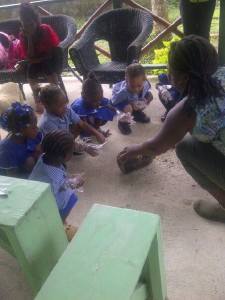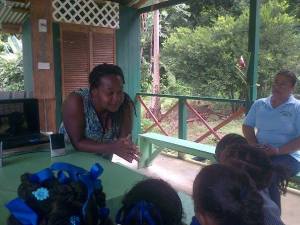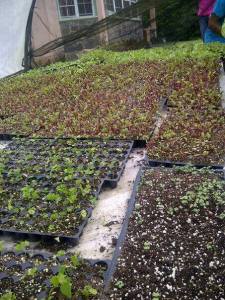
I love the name of this farm too.
Karen and Roy have never wavered from their dedication to farming organically and promoting organic farming within Dominica and the Caribbean.
They have an innovative way of marketing and selling their produce. They send out a weekly email describing what they have; you have time to peruse what’s available that week in the peace and quiet of your home/office; then you place your order by email at least 24 hours in advance. Then you pick it up at the Saturday market in Roseau. Their newsletters are informative and enjoyable to read.
You can just visit their booth at the Farmer’s Market Saturday morning if you wish but a few of their items are available only by email so always check to see if it is a request or special order item so you don’t get disappointed.
Roots Farm are there from about 6:30 AM to just after Noon.
Their table is right across from KFC on Hanover Street.
Note: there is a service charge of $5 for orders under $75.
The following is an example of their email newsletter.
THIS WEEK’S PRODUCE:
FRUITS & FRUIT TREES: Grapefruit, Red or White: 5/$2. For juice and fresh eating although still a little tart. Grapefruit helps control weight with flavonoids that block the uptake of fatty acids into cells, protects heart health with generous amounts of vitamin C, folic acid, potassium, and pectin, and helps protect against cancer. Pink and red varieties contain additional valuable anti-oxidants and red contains lycopene, a phytochemical that helps prevent the LDL cholesterol damage. Despite its own acidity, grapefruit has a beneficial alkalizing effect on the body. Cautions: grapefruit may halt the metabolism of some drugs, while excessive consumption can leach calcium from the body system, causing decay of the bones and teeth.
Strawberry Plants: in Flats: $10 each or 2 in same pot for $15. PLEASE REQUEST. These are a medium size real Northern type strawberry with very good real strawberry flavor. The type has been demonstrated to thrive and produce in higher elevations (Cochrane and Bellevue Chopin) in Dominica, but not tested, to my knowledge, along coast although the Taiwanese had a similar (same?) variety that did well in the Stock Farm area. Plants are vigorous producer of runners (more plants for you).
Tanmawen dezenn Seedlings: aka Tamawe de zen/Spanish Tamarind/Chinee tambran: (Vangueria madagascariensis): $20. PLEASE REQUEST. Well rooted, 2-2.5′ seedlings. Sweet, almost date like fruit, usually eaten dry in Dominica, although used fresh elsewhere. Grows as a profusely branched shrub or small tree, 2-15 m tall. Does best in drier parts of island. Species getting rare; deserves to survive: have room for a tree? ______________________________________________________________________
ROOTS
Turmeric aka “Saffwan”: 8 oz/$2.50. This celebrated health-boosting spice is not usually found organically grown and is easy to store for months. Mostly used dried, as in curry powder, fresh root tastes even better than dry grated into rice, beans, soups, etc. for color and warm, peppery flavor. Good grated into pesto or raw foods too. A true superfood, TCM and Ayurvedic Medicinal star known for strengthening and improving digestion, elimination and metabolism; supporting healthy liver function and detoxification; purifying blood; acting as an anti-inflammatory; containing curcuminoids that fight cancer, arthritis, and Alzheimer’s; and so much more. Note: surfaces (and hands) coming in contact with cut turmeric will get orange stains which eventually wear off. Also note that consuming with black pepper vastly increases the availability of turmeric’s healthful properties.
Yams, White & Lady’s: $2.50/lb Lady’s; $2/lb White. Limited supply. Yams provide some protein and a lot of starch, in the form of complex carbohydrates and soluble dietary fiber (which together are recommended as low glycemic index healthy food which also reduces constipation, decreases bad or “LDL” cholesterol levels, and helps prevent colon cancer). Yams also provide vitamin c and minerals.
VEGETABLES
Bean, Lima — fresh: $5/lb; $2.75/.5 lb. in shell (must be shelled before cooking); 7.5 oz/$6 shelled. Also called Butter Beans, fresh limas may just be the next best thing to edamame or fresh green peas. They also make an excellent hummus, replacing chickpeas. Cook lightly. Limas are a very good source of cholesterol-lowering, blood-sugar modulating fiber, making them an especially good choice for individuals with diabetes, insulin resistance or hypoglycemia. When combined with whole grains such as rice, lima beans provide virtually fat-free high quality protein. They are an excellent source of molybdenum and iron and can make a major contribution to heart and cardiovascular health due to their folate and magnesium content. Their manganese helps energy production and acts as an antioxidant to disable free radicals.
Bean, Lima — Dry: $9/lb. shelled. Limited supply Dry limas require long cooking like other dry beans, but similarly reward with flavor and nutrition. Limas are a very good source of cholesterol-lowering, blood-sugar modulating fiber, making them an especially good choice for individuals with diabetes, insulin resistance or hypoglycemia. When combined with whole grains such as rice, lima beans provide virtually fat-free high quality protein. They are an excellent source of molybdenum and iron and can make a major contribution to heart and cardiovascular health due to their folate and magnesium content. Their manganese helps energy production and acts as an antioxidant to disable free radicals.
Christophene/Chayote: 3/$2. Mild flavored and low calorie, christophene is most often served cooked but can also be enjoyed raw in salads. Skin and seed are also edible (as are leaves and roots). It is rich in amino acids, vitamins (especially Vitamin C and folate), antioxidants, minerals and fiber.
Edible “Hibiscus” (Hibiscus manihot, Bele or Abelmoschus manihot) – LEAVES: 10 oz/$2.50. Nice tasting, large highly nutritious leaves are mucilaginous, so are a good quick-cooking thickener for soups, but can also be steamed, stir-fried, or used as other greens. Bele makes the best ever “kale chips” (Wash & dry the leaves & spray or toss lightly with cooking oil, then sprinkle with salt & your choice of spices/herbs. Spread single layer onto baking pan and bake at 275-300 F about 10-15 minutes until crisp. Enjoy right away or store in air tight container to preserve crispness.) Also makes a great wrap, either raw or cooked, for your delectable fillings (see recipe at: http://www.ecobotanica.com.au/Stuffed-Vine-Leaves-Using-Edible-Hibiscus-Leaves-bgp1032.html), Among the most nutritious of greens, Bele is very high in vitamins A and C, in iron and protein. Used in numerous Asian healing systems to relieve inflammation, urinary infection, chronic bronchitis, pain and irritation. Its stems are antibacterial, anti-fungal, anti-viral. The bark is said to be emmenagogue, increasing menstruation and should be avoided by pregnant women. To be on safe side, perhaps leaves should be avoided as well by pregnant women. A paste of the bark is used to treat wounds and cuts; the root juice is warmed and applied to sprains; the juice of the flowers is used to treat chronic bronchitis and toothache; and the plant is thought to increase bone density.
Edible “Hibiscus” (aka Hibiscus manihot, Bele, Abelmoschus manihot) – STEMS: $1, 2 oz sample pack. PLEASE REQUEST. Lovely light-sweet flavor like nothing else I know, the stems are wonderful by themselves as a crunchy (but also slightly gooey) healthy snack or chopped into salads, soups, stir-fries; juiced into smoothies and green drinks; as crudités, etc. Lots of potential for creative use to capitalize on unique flavor. Older stems may need the outer layer peeled. Stems are antibacterial, anti-fungal, anti-viral. Please read cautions above for leaves.
Mustard Leaves: 50 cents/oz. Limited supply. Another of the cruciferous superstars (like kale & broccoli) whether used young and relatively mild or mature and strong flavored. Use fresh for pepping up your salad, sandwiches, omelets, or cooking. Mustard’s bite mellows somewhat when cooked. Mustard provides plentiful vitamins, minerals, fiber, detox & cardiovascular support, anti-oxidant & anti-inflammatory benefits. Folks with kidney and/or gallbladder problems should probably avoid due to oxalate content. Lots of good info at: www.whfoods.com
Pumpkin: $1.25/lb whole; VERY LARGE pumpkins. $2.00/lb. slices. Fully ripe & dry. Typical Dominican sweet delicious pumpkin delivers the vitamin benefits of both a fruit and a vegetable. Like other orange vegetables, pumpkin has high vitamin A content. It also has significant amounts of vitamin C, riboflavin, niacin, pantothenic acid, B-6 and folate and provides iron, potassium, calcium and magnesium.
Sweet Potato Greens: 10 oz/$2.50. Say what? Sweet potato leaves are delicious and nutritious and widely used in Africa and Asia. Steam, saute, add to soups and stews or cook like any quick-cooking green. According to FAO leaflet No. 13 – 1990, they are a good source of vitamins A, C, and B2 (riboflavin), and an excellent source of lutein. According to research from the University of Arkansas, sweet potato leaves are high in disease-fighting antioxidants, containing 15 different compounds helpful for preventing heart disease, diabetes, infection and some types of cancer.
HERBS
Basil: $2.50/Regular Mix; $3/any single variety or special mix. Protects cell structures as well as chromosomes from radiation and oxygen-based damage and provides protection against unwanted bacterial growth, including the ability to inhibit several species of pathogenic bacteria that have become resistant to commonly used antibiotic drugs. In addition, basil qualifies as an “anti-inflammatory” food that can provide important healing benefits along with symptomatic relief for individuals with inflammatory health problems like rheumatoid arthritis or inflammatory bowel conditions. Basil is a good source of nutrients essential for cardiovascular health, including Vitamin A and magnesium, as well as iron, calcium, potassium and vitamin C. As a member of the Mint family, basil is used for its digestive and anti-gas properties. Herbalists also recommend it for stomach cramps, vomiting, constipation, headaches, and anxiety. We have the following types available. Please let us know if you want us to bring a specific type for you.
Basil, Holy Green aka Tulsi: $3. Stars in Ayurvedic healing as: nerve tonic, stomach, heart and kidney strengthener, dengue preventive, and blood purifier as well as for stress, memory, fever, colds and flu, coughs, skin disorders, headaches, eye problems, hypertension, and much more. Lovely in a bouquet or for tea or cooking, but not really a culinary substitute for Italian/pesto basils. Recent fame as a Swine Flu deterrent/ameliorative. See: www.holy-basil.com
Basil, Holy Red: $3. PLEASE REQUEST. Like Holy Green Basil, but stronger tasting, Holy Red is a super herb medicinally: supports cortisol, blood sugar, protects cells from radiation damage, and so much more. Also lovely in a bouquet or for tea or cooking, but not really a substitute for Italian/pesto basils.
BASIL MIXES:
Basil Regular/Tea Mix: may include: Lemon, Thai, Malaysian, Holy Red, Holy Green (Tulsi), East Indian, Cinnamon/Mexican, Italian, Anise, various showy spicy purple basils, local (Spicy Globe) and more. May contain dark colors or stronger flavors than the Pesto or Southeast Asian mixes. Good for teas, but also for cooking or salad herbs. Basil protects cell structures as well as chromosomes from radiation and oxygen-based damage and against unwanted bacterial growth. In addition, it qualifies as an “anti-inflammatory” food that can provide important healing benefits along with symptomatic relief for individuals with inflammatory health problems like rheumatoid arthritis or inflammatory bowel conditions. Basil is a good source of nutrients essential for cardiovascular health, including Vitamin A and magnesium, as well as iron, calcium, potassium and vitamin C..
Basil, Pesto Mix: $3. Heavy on Italian, Thai, Malaysian, Lemon, Blue Spice & other varieties that make a great pesto and none of the stronger tasting (e.g., East Indian, Anise, Cinnamon) or red varieties. Do try substituting cooked breadnuts for pine nuts/almonds and coconut oil for olive oil for a wholly local version of pesto that equals or betters the traditional Italian. Purslane or papalo can be added to increase the nutritional value and add further depth to the taste. Basil,
SouthEast Asian Mix: $3. PLEASE REQUEST. Thai and Malaysian varieties. In SE Asian cooking, these are usually added at the very end of cooking to retain bright green color. Can also be used for pesto.
Bay Leaves: Fresh. PLEASE REQUEST. In addition to its culinary uses (soups, stews, sauces, etc.), Sweet bay is used medicinally as a tea to soothe the stomach and relieve flatulence and in ointments to relieve the aches and pains associated with rheumatism, and for sprains, bruises, and skin rashes. Do not use if pregnant or breast-feeding.or are scheduled for surgery in the next two weeks as it might cause excessive sedation combined with medications. Folk use: Cancer, dandruff, and relieving gas.
Chinese Garlic Chive aka Chinese Leek: Wonderful in and on most everything, raw or cooked (add at end of cooking for best flavor). Flavor like a mild garlic-onion cross. Low fat, high in fiber, Vitamin C and carotene, plus moderate calcium, Vitamins B1 and B2. In Chinese medicine, garlic chives are considered to be a yin or warming food that like other members of the garlic and onion family, contain a sulphur-rich mustard oil that aids digestion and helps promote the flow of blood.
Chive, Fine: PLEASE REQUEST. Limited supply. Used for delicate “onion” flavor, raw or cooked, and as a garnish. Chives aid digestion and stimulate appetite, are good for the respiratory system, help reduce the risk of prostate cancer, and have anti-inflammatory and antibiotic properties.
Culantro/Chadron Benee/Shado beni/Recao: By any name, this herb tastes like cilantro and is used similarly, as well as starring in Puerto Rican specialties like sofrito and salsas. Nutritionally, it offers calcium, iron, carotene, and riboflavin. Its medicinal value includes as a tea for pneumonia, flu, diabetes, constipation, depression, fevers, and blood purification. It is also used in chutneys as an appetite stimulant and is reported to have anti-convulsant properties and to help with vomiting and diarrhea. In addition to packages of leaves, we can supply the flower/seed scapes, the plant part most commonly used locally in tea, rum or food.
Dill: Limited supply. PLEASE REQUEST. Most commonly used in pickles, salads and fish dishes, dill has chemoprotective and bacteriostatic properties and is a very good source of calcium. Dill is also a good source of dietary fiber and the minerals manganese, iron and magnesium.
Lemon Balm: PLEASE REQUEST. Mint family herb useful in salad or for fish, also makes a lovely, almost flowery) tasting tea with antibacterial and antiviral properties (effective against herpes simplex) also useful as a mild sedative or calming agent. Try it in your own unique version of Mojito. Lemon balm should be avoided by those on thyroid medication as the herb may inhibit absorption.
Lemon Grass PLEASE REQUEST. With the bulb for Thai and other SE Asian (and other) recipes; leaves for tea. Grating the bulb or fine slicing it into whatever sauce, curry, stir-fry, etc. you are making gives a lovely flavor accent and benefits of the fiber and other nutrients, but the stalk and leaves could also be pounded or bruised and added to your pot for flavor and removed before serving. Lemongrass, ginger and garlic are wonderful as flavoring combo. for a winged bean stir-fry. See recipes at: recipes.epicurean.com. Lemongrass has many antioxidant, anti-tumor, antibacterial, and antifungal agents. It is used as a sedative/calming agent, to detoxify digestive organs, to stimulate digestion and blood circulation, and for hypertension.
Mints Mix Peppermint, Spearmint and a local (lovely, but unknown variety) mint. Culinary use in salads, mint jelly, tea, mojitos, more. Relieves many kinds of stomach distress, contains phytonutrients shown to stop growth of tumors, inhibits various bacteria and fungal growth, has anti-oxidant properties, helps airways stay free in asthma and colds, and provides nutrients like manganese, vitamin C and vitamin A, dietary fiber, folate, iron, magnesium, and calcium, vitamin B2, omega-3 fatty acids, potassium and copper. And we haven’t even mentioned mojitos yet.
Moringa Leaves, fresh (Dry also available): 2 oz/$3. Currently widely hyped but with good reason as Moringa is a powerful nutrient rich food, potent detoxifier, and therapeutic support for numerous health challenges and conditions. Loaded with vitamins and minerals, and protein with all 8 essential amino acids, plus others, and 46 anti-oxidants, it also tastes good (slightly spicy) fresh in salads, as garnish, in green drinks or lightly cooked addition to most anything. Moringa functions as an anti-inflammatory, antibacterial, antiparasitic. It balances sugar and cholesterol levels, stimulates the immune system and metabolism, supports digestion and protects liver and kidneys. Caution: may not be appropriate for those taking blood-thinning medications and the seeds, powerful detoxicants, may cause problems with intestinal walls, kidney & liver if taken daily or in excessive amounts. Leaves can be utilized daily. See: https://www.youtube.com/watch?v=T3retnQVSOs&feature=share Click HERE for even more about Moringa.
Parsley, Italian Flat: A little milder and sweeter than curly parsley and used the same. Has similar anti-oxidant and anti-carcinogenic properties, benefits heart health and rheumatoid arthritis, and provides generous amounts of Vitamins K, C, A, and Folate, plus iron. Makes a great tabouleh.
Parsley, Japanese, aka Mitsuba: PLEASE REQUEST. Unique flavor, said to taste like angelica, celery, and parsley. All parts are edible, fresh or cooked in soups, salads, tempura batter, rice, as seasoning, etc. Cook lightly only as it can get bitter and lose taste if cooked for more than a few minutes. Offers Vitamins A, B’s, C, E and K, as well as minerals. Medicinally used for women’s complaints and in the treatment of hemorrhages, colds, and fevers.
Sage: Limited supply. PLEASE REQUEST. Culinary. American traditional favorite for poultry, stuffings. sausages, ground meats, fish, salads, soups, and stews. Also serves as an antispasmodic, antiseptic, astringent, diaphoretic, expectorant, nervine, and tonic. Small bunches.
Shimonita Scallions: 60 cents/oz, about $3-4/stem, depending on size. PLEASE REQUEST. Large Sweet Scallion variety from Japan: Very special. No waste: the green tops are delicious cooked in most everything. You’d be hard pressed to tell this from leeks by flavor, although texturally leeks are creamier after cooking. Like other scallions or “sive,” Shimonita has vitamin and mineral benefits (vitamin K, essential to blood clotting and strong bones; vitamin A, supporting eye health and cellular function; vitamin C with its antioxidant and many other virtues; folate, for energy production and birth defect prevention; Calcium, strengthening bones and teeth; Magnesium, which helps with muscle contraction, energy production and enzyme and protein activity; Potassium for regulating electrical activity, including heart beat, mineral and fluid balance; and manganese, a trace mineral that acts as an antioxidant. TCM uses scallions for dispersing chill and colds, relieving congestion, fighting fungal and bacterial infections, and relaxing muscle tension.
Soursop Leaves: PLEASE REQUEST. Fresh or dry. Lovely tasting tea is used for sleep inducing qualities and cancer prevention and cure. Scientific research conducted by The U.S. National Cancer Institute concluded that Soursop leaves can effectively attack and destroy cancer cells. In addition to this, folk uses include for: inflammation, rheumatism, diabetes, nerves, skin conditions (boils, eczema, etc.), liver, bladder & uric acid, and many more uses. Not for use by folks with low blood pressure or taking hypertensive drugs without proper monitoring of blood pressure.
Thyme, Broad Leaf aka Grosdite: aka Cuban oregano, Spanish Thyme. PLEASE REQUEST. Used for chicken, fish, meat, beans, pelau, risotto, as part of Jamaican “jerk” seasoning, and as part of green seasoning. Can be used in same ways as common thyme, but has stronger flavor, and is often used chopped fresh. Grosdite has antibacterial and fungicidal properties and is used for stomach complaints, fevers, colds, coughs, sore throats, infections, rheumatism and flatulence.
CHOCOLATE! CHOCOLATE BARS: $15/4oz or 110 gm bar. A not overly sweet treat made by Alan Napier at Pointe Baptiste estate in Calibishie. Bars may be ordered from the list below or you can take your chances at the table. Nearly all the cocoa used is grown organically either on the estate or bought from people who grow their cocoa organically. Currently we have the following varieties in stock: Coffee chocolate with organic Robusta coffee; 60% cocoa Dark chocolate with 80% cocoa Ginger chocolate with 60% cocoa Hot Pepper chocolate with 60% cocoa Milk chocolate with 50% cocoa — SOLD OUT Mint chocolate with 60% cocoa Spice chocolate with nutmeg, cinnamon and clove; 60% cocoa Tangerine chocolate with 60% cocoa
COCOA POWDER: SOLD OUT temporarily $5/100 gm packet. PLEASE REQUEST. This is 100% cocoa powder, derived after Alan presses the cocoa to extract the cocoa butter (which he then mixes with more cocoa to make chocolate. The cocoa powder is used for making cakes, cocoa tea, etc. In Europe it is sold in shops as Vanhouten cocoa powder. This is really beautiful delicious cocoa. For a special treat try these divine Chocolate Energy Balls: http://www.mindbodygreen.com/0-10534/raw-recipe-chocolate-energy-balls.html _________________________________________________________________________________
ORGANIC FERTILIZERS: $15/2 Kg Bag. PLEASE REQUEST. Imported from Belgium by W.M. Hollerman. (Holldom2@gmail.com, 316-2026) from whom larger size bags are also available. This is what we use, along with our own compost and pen manure (when we can get it uncontaminated with antibiotics or arsenic or other of the problematic additives to commercial feed passed through to the manure). We are very impressed with the results we get from this line of fertilizers. Three formulas are available:
VIVISOL: SOIL CONDITIONER/MICROBIAL STIMULATOR: Use in each planting hole, when planting new fields and also after sowing/incorporating young plants in the soil. Provides organic matter, improves physical and biological soil fertility, increases water retention capacity, improves soil structure. The stimulation of soil life will result in higher yields, especially for tropical fruit trees. Use 5-15 kg/100m2 or about one 8 oz cup per square meter or per 3.2×3.2 foot (10.7 square feet)
VIVIKALI — FRUITS, ROOTS, TUBERS, ORNAMENTALS: Slow, continuous release provides a lot of potassium and is best used 1.5 months before fruit formation to give a lot of energy to form big thick juicy fruits or root and tuber crops or for ornamentals not needing nitrogen. Apply 5-10 kg/100 m2 or about 4 oz. per square meter or per 3.2×3.2 foot (10.7 square feet)
PLANTORGANO — BASIC FERTILIZER, VEGETABLES: Good as an initial first fertilization or together with Vivisol in the planting hole or after sowing/planting. Apply 10-15 kg/100 m² or about one 8 oz cup per square meter or per 3.2×3.2 foot (10.7 square feet) (depending on the crop)





